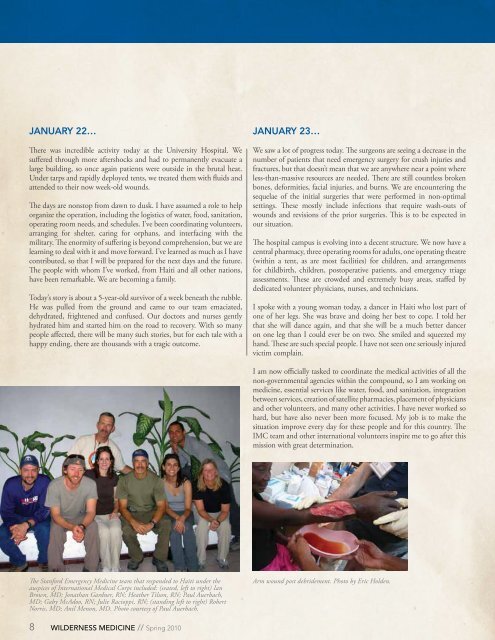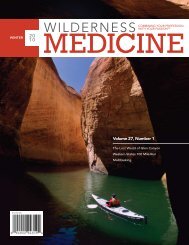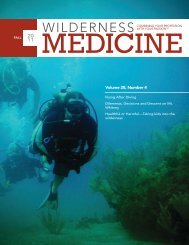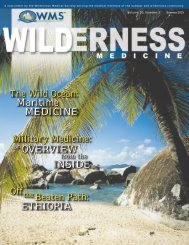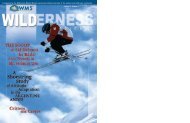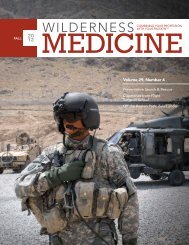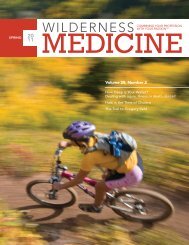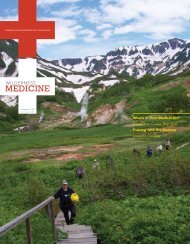Volume 27, Number 2 - Wilderness Medical Society
Volume 27, Number 2 - Wilderness Medical Society
Volume 27, Number 2 - Wilderness Medical Society
You also want an ePaper? Increase the reach of your titles
YUMPU automatically turns print PDFs into web optimized ePapers that Google loves.
January 22…<br />
There was incredible activity today at the University Hospital. We<br />
suffered through more aftershocks and had to permanently evacuate a<br />
large building, so once again patients were outside in the brutal heat.<br />
Under tarps and rapidly deployed tents, we treated them with fluids and<br />
attended to their now week-old wounds.<br />
The days are nonstop from dawn to dusk. I have assumed a role to help<br />
organize the operation, including the logistics of water, food, sanitation,<br />
operating room needs, and schedules. I’ve been coordinating volunteers,<br />
arranging for shelter, caring for orphans, and interfacing with the<br />
military. The enormity of suffering is beyond comprehension, but we are<br />
learning to deal with it and move forward. I’ve learned as much as I have<br />
contributed, so that I will be prepared for the next days and the future.<br />
The people with whom I’ve worked, from Haiti and all other nations,<br />
have been remarkable. We are becoming a family.<br />
Today’s story is about a 5-year-old survivor of a week beneath the rubble.<br />
He was pulled from the ground and came to our team emaciated,<br />
dehydrated, frightened and confused. Our doctors and nurses gently<br />
hydrated him and started him on the road to recovery. With so many<br />
people affected, there will be many such stories, but for each tale with a<br />
happy ending, there are thousands with a tragic outcome.<br />
January 23…<br />
We saw a lot of progress today. The surgeons are seeing a decrease in the<br />
number of patients that need emergency surgery for crush injuries and<br />
fractures, but that doesn’t mean that we are anywhere near a point where<br />
less-than-massive resources are needed. There are still countless broken<br />
bones, deformities, facial injuries, and burns. We are encountering the<br />
sequelae of the initial surgeries that were performed in non-optimal<br />
settings. These mostly include infections that require wash-outs of<br />
wounds and revisions of the prior surgeries. This is to be expected in<br />
our situation.<br />
The hospital campus is evolving into a decent structure. We now have a<br />
central pharmacy, three operating rooms for adults, one operating theatre<br />
(within a tent, as are most facilities) for children, and arrangements<br />
for childbirth, children, postoperative patients, and emergency triage<br />
assessments. These are crowded and extremely busy areas, staffed by<br />
dedicated volunteer physicians, nurses, and technicians.<br />
I spoke with a young woman today, a dancer in Haiti who lost part of<br />
one of her legs. She was brave and doing her best to cope. I told her<br />
that she will dance again, and that she will be a much better dancer<br />
on one leg than I could ever be on two. She smiled and squeezed my<br />
hand. These are such special people. I have not seen one seriously injured<br />
victim complain.<br />
I am now officially tasked to coordinate the medical activities of all the<br />
non-governmental agencies within the compound, so I am working on<br />
medicine, essential services like water, food, and sanitation, integration<br />
between services, creation of satellite pharmacies, placement of physicians<br />
and other volunteers, and many other activities. I have never worked so<br />
hard, but have also never been more focused. My job is to make the<br />
situation improve every day for these people and for this country. The<br />
IMC team and other international volunteers inspire me to go after this<br />
mission with great determination.<br />
The Stanford Emergency Medicine team that responded to Haiti under the<br />
auspices of International <strong>Medical</strong> Corps included: (seated, left to right) Ian<br />
Brown, MD; Jonathan Gardner, RN; Heather Tilson, RN; Paul Auerbach,<br />
MD; Gaby McAdoo, RN; Julie Racioppi, RN; (standing left to right) Robert<br />
Norris, MD; Anil Menon, MD. Photo courtesy of Paul Auerbach.<br />
Arm wound post debridement. Photo by Eric Holden.<br />
8 WILDERNESS MEDICINE // Spring 2010


